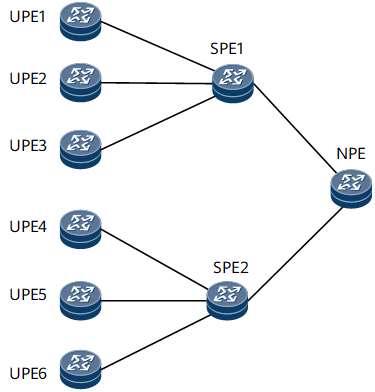(Optional) Configuring Route Regeneration
On an HVPN, UPEs can communicate with each other through SPEs and NPEs. You can configure route regeneration on SPEs to reduce the number of VPN labels assigned to VPNv4 routes received by the UPEs.
Context
On the HVPN shown in Figure 1, different UPEs communicate with each other through SPEs and NPEs. When there are a large number of UPEs, if the per instance per label mode is configured for the VPN instances and the per next hop per label mode is configured for the VPNv4 address family of the SPEs, the UPEs have to receive a large number of labels. If the UPEs have comparatively low capacity, a traffic forwarding error may occur.
To solve this problem, configure route regeneration on the SPEs so that the VPNv4 routes received by the SPEs are imported into the VPN instances. The VPN instances regenerate these routes and then advertise them to the VPNv4 address family. Because the per instance per label mode is configured for the VPN instances, one label is allocated per VPN instance when the regenerated routes are advertised to the UPEs, which reduces the number of VPN labels assigned to VPNv4 routes.
Perform the following steps on each SPE.
Procedure
- Run system-view
The system view is displayed.
- Run bgp as-number
The BGP view is displayed.
- Run ipv4-family vpn-instance vpn-instance-name
The BGP-VPN instance IPv4 address family view is displayed.
- Run advertise [ best-route | valid-routes ] route-reoriginate
The VPN instance is configured to advertise regenerated routes to the VPNv4 address family.
- Run commit
The configuration is committed.
- Run quit
Return to the system view.
- Run bgp as-number
The BGP view is displayed.
- Run ipv4-family vpnv4
The BGP-VPNv4 address family view is displayed.
- Run peer { ipv4-address | group-name } enable
The ability to exchange BGP VPNv4 routes with the specified BGP peer is enabled.
- Run peer { ipv4-address | group-name } advertise route-reoriginated vpnv4
The SPE is configured to advertise regenerated routes in the VPNv4 address family to the BGP VPNv4 peer.
- Run commit
The configuration is committed.

To reduce the number of VPN routes assigned to the VPNv4 routes received by a UPE and use a route policy to prevent an SPE from advertising its received original routes to a peer, perform configurations according to Using a Routing Policy to Filter the BGP Routes to Be Advertised.
Verifying the Route Regeneration Configuration
Run the display bgp vpnv4 all routing-table network to check information about the VPNv4 routes. Each regenerated VPNv4 route is displayed with the reoriginated attribute.
